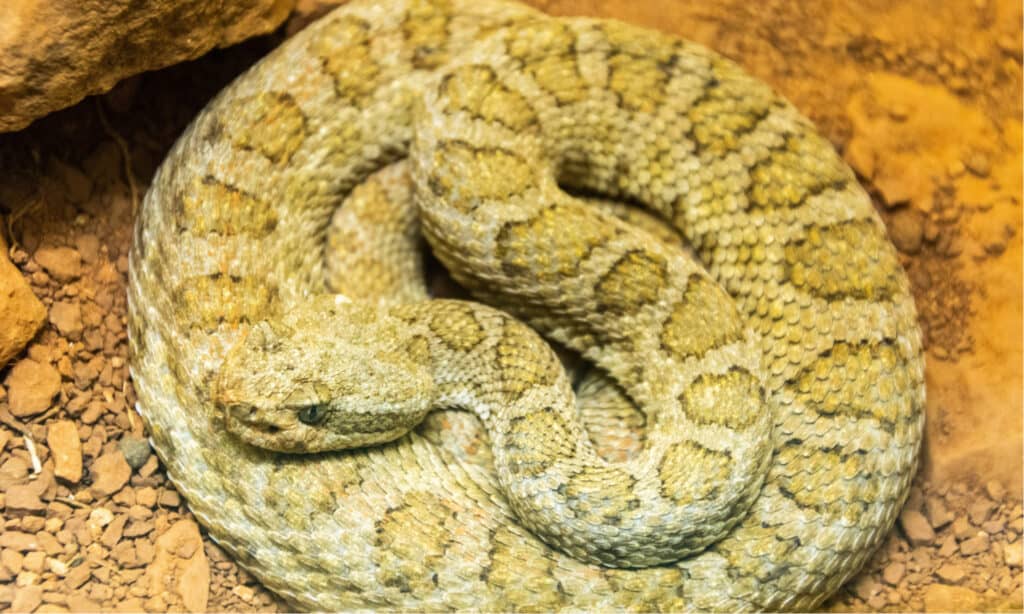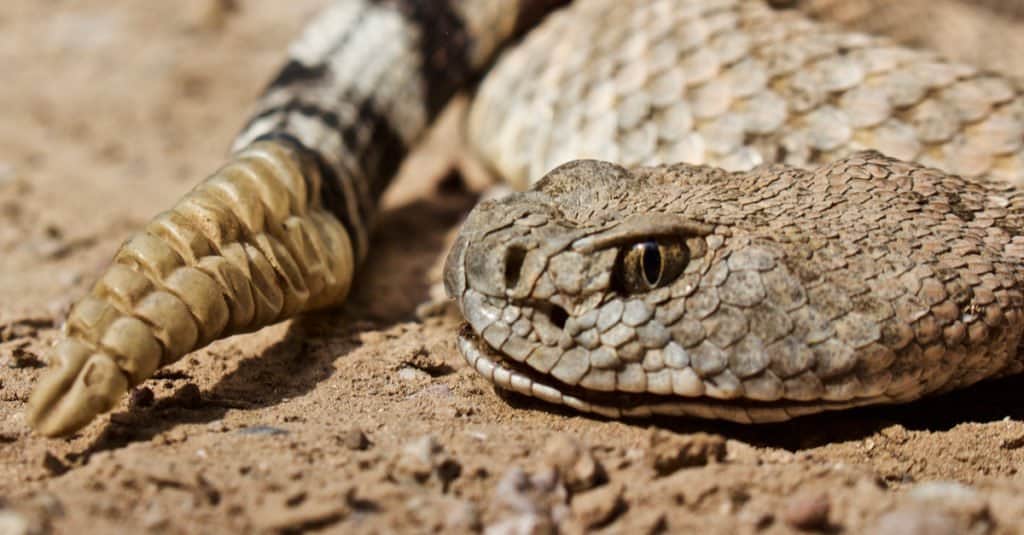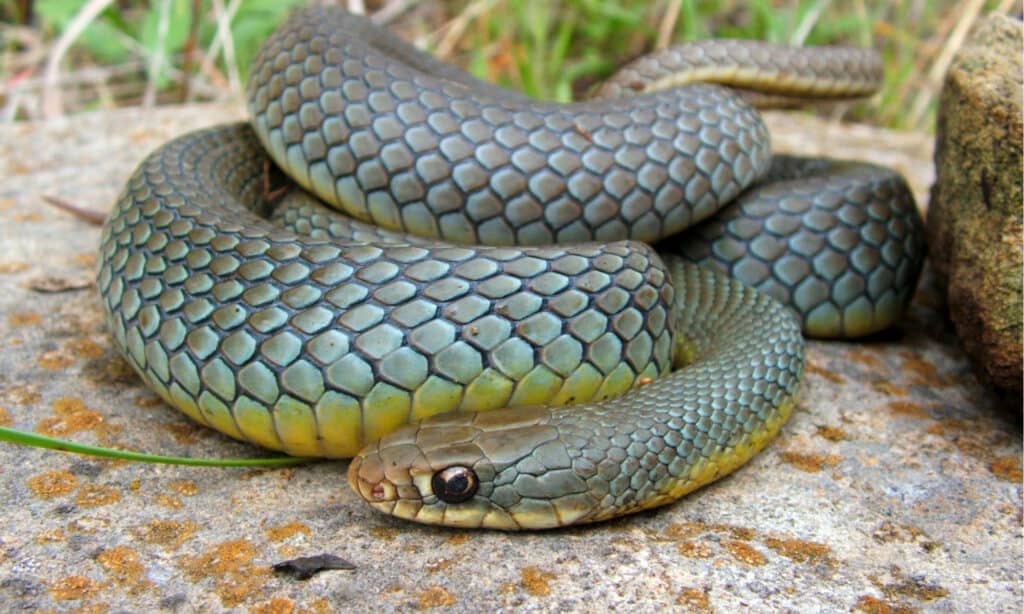Colorado is undeniably one of the most breathtaking states for its natural beauty and magnificent scenery. For the outdoor lovers, you really could not do better than this state for a summer vacation. But those gorgeous mountain vistas and amazing forests are also home to snakes, and any outdoor fan can tell you that knowing all about the snakes in an area can do more than educate; it can keep you safe!
Colorado is home to four species of venomous snakes, and all of them are rattlesnakes. Though some species of rattlesnakes may not have a bite that can kill an adult human, any bite from a venomous snake can cause serious health issues. But can any of Colorado’s rattlesnakes level a deadly dose of venom that can kill? We will start with the smallest species and work our way up to the state’s largest and most dangerous snake!
The Top Three Largest (And Most Dangerous) Snakes In Colorado
The Midget Faded Rattlesnake

The midget faded rattlesnake is the third largest and most dangerous snake found in Colorado.
©Alizada Studios/Shutterstock.com
Size: 20-30 inches long.
Locations: Rocky cliffs and shrubs, primarily found in the Green River/Colorado river regions.
Danger: Venomous; bite can cause severe injury without treatment.
Behavior: Moderately aggressive but reclusive. Bites occur due to accidental contact or provocation.
Midget faded rattlesnakes can be identified by their tan/light brown/overall yellow coloring and reddish-brown markings outlined in deep brown. While these markings are like other rattlesnake species, they often appear washed out or “muted,” hence the species’ common name.
While the midget faded rattlesnake’s preferred habitat is near rocky cliffs or areas with shrubs, they are mostly found along the Green River or Colorado River regions in the state. They are quite common but are thankfully reclusive. While a bite may be painful and need prompt medical care, they rarely, if ever, result in death.
The Desert/Western Massasauga Rattlesnake

The western/desert massasauga rattlesnake species are the second largest and most dangerous snakes in Colorado.
©Rusty Dodson/Shutterstock.com
Size: 12-36 inches.
Habitat: Wetlands, near water sources, plains.
Danger: Moderately aggressive, the venom can cause life-threatening health problems if left untreated.
Behavior: Moderately aggressive. Most bites occur through accidental contact.
Western massasauga rattlesnakes are pale brown or tan overall, with darker mottling that appears blurred or muted. Unlike other rattlesnake species, the western massasauga has nine distinctive large scales on the top of its heads. The desert massasauga shares similar markings but is overall lighter in coloring due to its habitat in drier areas, like sand or plains locations.
Both species are found in Colorado, but the western species are more commonly spotted.
The Prairie Rattlesnake

The prairie rattlesnake is the largest and most dangerous species of snake in Colorado.
©DMartin09/Shutterstock.com
Size: 35-45 inches long.
Locations: Grasslands, plains, foothills, and mountains.
Danger: Venomous; bite can be deadly without medical treatment.
Behavior: Moderately aggressive. Bites occur due to accidental contact or provocation.
Prairie rattlesnakes are light brown, grey, or green overall, with darker mottled markings. There are thirty-two kinds of prairie rattler, and markings range from brown, tan, or white, depending on the species.
In addition to being the largest of Colorado’s three rattlesnake species, they are also highly common. This species is found throughout the state but is thankfully shy and prefers to be far away from human locations!
Honorable Mention: The Non-Venomous (But Really Common) Yellow-Bellied Racer

The yellow-bellied racer is not dangerous and is even legal to have as a pet in Colorado.
©Matt Jeppson/Shutterstock.com
Yellow-bellied racers are one of the most common snakes found in Colorado, but they are not venomous. Though they could be mistaken for dangerous snakes due to their vibrant blue/grey bodies, their distinctive bright yellow bellies easily identify them. Commonly found in grasslands, meadows, and mountain regions, they are thin, agile snakes with small heads and rounded eyes.
In the world of snakes, racer species are known for their agility and speed. The yellow-bellied racer is extremely quick and non-aggressive, making it legal to own them as pets in Colorado. However, they rarely adapt to handling and will bite.
Also, if you want to keep a yellow-bellied racer, you must catch it first. Racers can move up to 3.5 miles an hour!
Summary of Discover the Top Three Largest (And Most Dangerous) Snakes In Colorado This Summer!
| Rank | Snake |
|---|---|
| 1 | The Midget Faded Rattlesnake |
| 2 | The Desert/Western Massasauga Rattlesnake |
| 3 | The Prairie Rattlesnake |
The photo featured at the top of this post is © DMartin09/Shutterstock.com
Discover the "Monster" Snake 5X Bigger than an Anaconda
Every day A-Z Animals sends out some of the most incredible facts in the world from our free newsletter. Want to discover the 10 most beautiful snakes in the world, a "snake island" where you're never more than 3 feet from danger, or a "monster" snake 5X larger than an anaconda? Then sign up right now and you'll start receiving our daily newsletter absolutely free.
Thank you for reading! Have some feedback for us? Contact the AZ Animals editorial team.







